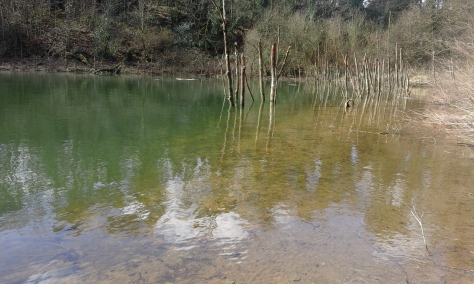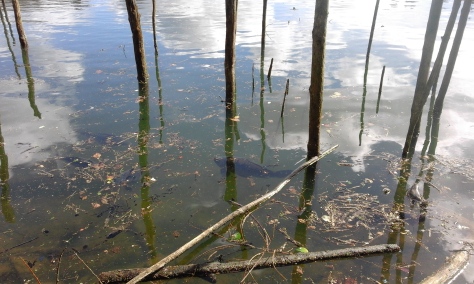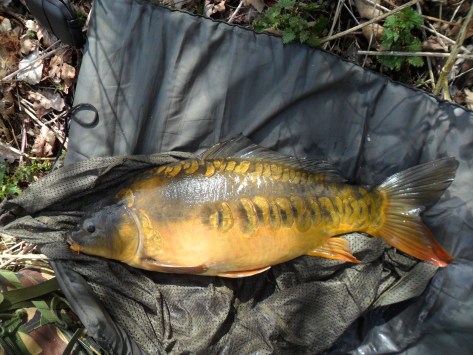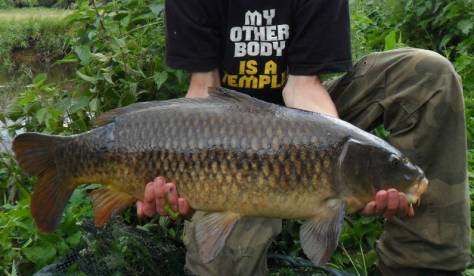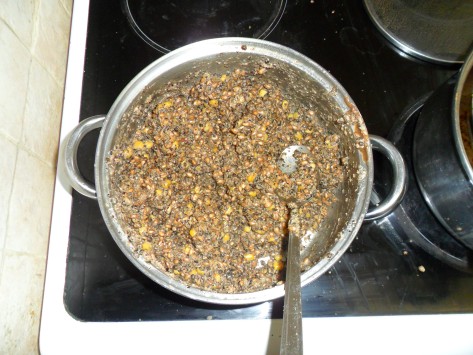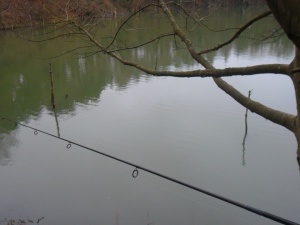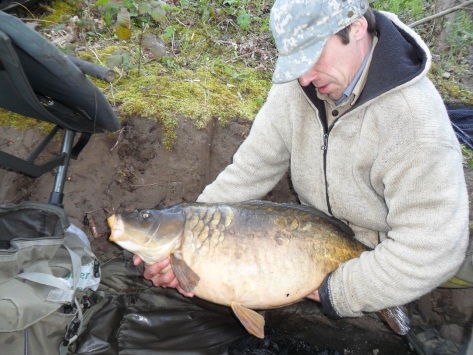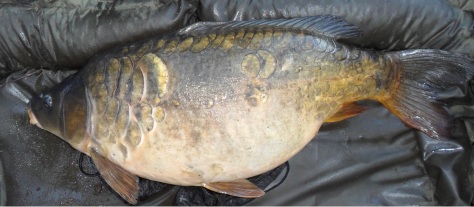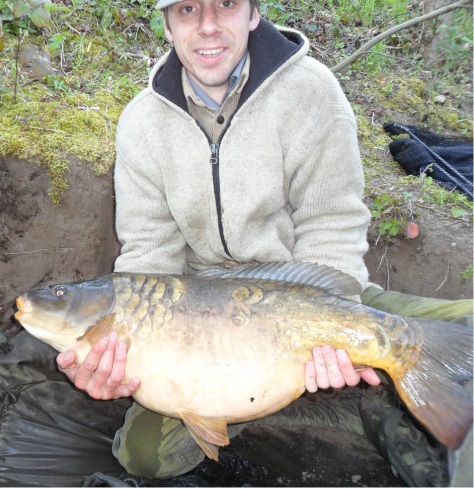‘So you arrive at the bankside and quietly set up your rod and tackle and soon you have cast out and have settled down to wait. But do not expect the carp to bite very early in the morning (I am thinking of July). You may not get a run until the sun is up over yonder elms and his bright rays have dispelled the last of the smoking vapours. But the important thing is that you will be there before the carp are looking for their breakfast, they will not feel you walking along the bank.’
BB – Confessions of a Carp Fisher
I was quite buoyed by my success and how easy it had been to catch at my last visit. The next day, I returned as the weather was sunny and the weather front unchanged. As I waded round to the secluded north-westerly corner of the lake that is marked by the array of fallen tree stumps in the shallow, sandy shoreline I thought back to my initial visit and my first capture almost exactly two years ago.
After my capture yesterday, the carp had promptly melted away. This was predictable behaviour; however, less so was what occurred when the carp had briefly become stuck around the narrow stump. Upon watching him flail about a little, before promptly deciding all was lost and proceeding to lie, gasping, on his side near the surface in a rather dramatic fashion, five or six of his smaller brethren then swiftly swum over to see why he was making such a fuss. They arrived in a procession, largest first, and proceeded to circle around him whilst I was rotating the long rod overhead and thus unwinding the line from the snag. Unable to assist, they were reluctant to leave until he was free and started to make little runs again in a bid for freedom. At that point I had gently handlined him in and scooped him up with one big hand onto the top of my thigh high waders, placed the rod down and unhooked him.
I have seen carp act like this before, and chub too, when they witness one of their number get hooked. It is quite endearing really and the bond that carp enjoy must be quite strong. They will normally stay in the same year groups for life and, even in the wild, this may still be well in excess of sixty years. In fact, the oldest carp on record died on July 7, 1977 at a grand old age of 226. Born in 1751, Hanako, as she was known, was born in Japan in the first year of Horeki in the middle of the Tokugawa Era.
As the years progress, natural selection takes its course and these year groups are whittled down to a few survivors; in less forbidding waters where survival rates are greater, the year groups may split up, coming together solely to spawn or for occasional socials which generally revolve around food or sunbathing. It is interesting that in gravel pits, different year groups, or shoals, will find their own ways around the place and once these paths are set they are used routinely. It is this fact that enables us to trap them quite easily, given sufficient time and an understanding of how the weather usually affects their behaviour within that specific lake. Where these paths cross, you may have a ‘hotspot’; the equivalent of a busy junction that sees regular traffic.
I have often found it easier to set a trap on a route or junction I have discovered, than within an existing feeding area. This is because carp can become quite single-minded and will often visit a specific area to feed on a specific item, such as bloodworm. Although you can entice them here – because they are feeding – after a while the larger specimens tend to become wise to your intentions and may enter the area, feed solely on what they came for and then depart, leaving your hookbait, and even your free offerings, completely untouched. This is part of the reason that many carp anglers search for baits that will trigger the fish to pick them up and this has been achieved to some extent. Carp are also extremely curious and, in that way, remind me of cats. Many a big and wary carp has been taken down on a single, pineapple pop-up whence before they have ignored all efforts to entice them on the conventional favourites, many of which I have mentioned in my post on bait. I have little time for turning the art of carp fishing into a biology lesson however and privately feel that the endless quest for the holy grail of carp bait, something the carp simply cannot refuse, is truthfully more about a finding a means for the poor angler to compensate for a lack of watercraft. Tench, however, can be quite impossible and some will simply not eat bait at all. I have watched them feed on mud all around a baited area and ignore everything: maggots, hemp, breadcrumbs, casters, luncheon meat. Nothing will they eat. After sifting the mud all around, I have watched the same specimen sized tench shuffle on, still feeding, apparently oblivious to the banquet laid on for their benefit. Quite maddening in truth. My quest for a double figure tench continues… Carp, on the other hand are not that difficult to catch. In waters that have seen little bait, prebaiting is the key. Once switched onto a food source, they will eat it until they learn to associate it with being caught.
Wading on round to the scene of yesterday’s success, I could not see anything at first. Ten minutes later, I concluded that was because there was nothing to see. There was nothing here today. I pondered if this was possibly because it was now afternoon; perhaps they warm up here in the morning and then head back out to the middle, or elsewhere, during the daytime. I waded back round to the main swim. There only is one swim on this lake really, other than the one I have dug out, and this is where I first caught Dimple two years ago.
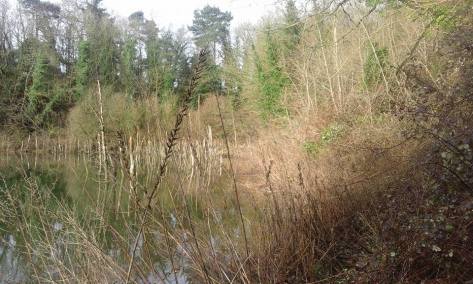
I put the rod together and checked the depth again out in front of me where a few tree tops break the surface and was reminded that it is still extremely deep. I counted fourteen feet off the float I used as a marker, but when I leaned right out with my 13 foot rod, tightened down to the waters surface and pulled the float up vertically, I saw it was closer to twenty feet deep as the length of line I pulled up leading to the lead below it was far, far beyond the length of my 13 foot rod. I checked the depth again a few times randomly, feeding off the line in one foot lengths until the float appeared and it stubbornly remained uniform at about fourteen feet – I have never really trusted this method of mapping the bottom and I still don’t – despite people’s assurances to the contrary, I remain convinced that it is wildly inaccurate!
The bottom of this old sand pit, which was later an open landfill site, has since been filled and levelled out. It is flat and uniform and sandy and barren. Truly, I have no idea what these carp eat.
I threw in some bait to the left of the treetops and fished for a while. I had intentionally waited for the promised thunderstorm, willing to suffer it if it would switch the carp onto feed and I could find out where that might be. The drop in barometric pressure can cause them to get their heads down, a phenomenon I have written about in a previous post on thunderstorms. Well, it rained all right, in fact it absolutely chucked it down. I saw nothing. I caught nothing. Upon returning home, I had to have a hot shower to rediscover my hands – it is still March after all and lots of that rain was actually small hailstones.
Today, now two days since my capture, I returned to the lake this morning. For the purposes of brevity, I fished today over my prebaited spot, saw nothing and caught nothing. Waded round, twice and visited the tree posts – nothing has returned since I slipped the little fella back there. How do they communicate? I don’t know really; I know that they secrete a pheromone of sorts when in distress through their skin which lets other fish know that there be a problem, but I thought that just dispersed in the water fairly quickly and then the carp would be back within a day, or two at the most. They are not back and do not appear to be coming back either. I reflected on the fact that although I caught Dimple twice in short order back in 2014, the second time it was from the swim I had dug out, in other words, right on the other side of the lake.
I packed up about midday, drove around the lake and went back to my dug out swim and walked that bank. Nothing. I also saw how appallingly open the main swim is. You are like a lighthouse standing up on that bank and I just cannot fish it regularly or it is inevitable I will get snitched on, leading to me potentially being fined or even arrested. In any event, the fence I have to nip through to get there is almost bang opposite a busy road junction where cars queue almost non-stop to turn either right or left. I have to wait around for ages for a break in the traffic before getting out and there is a steep and slippery muddy bank to scramble up and over at the fence approach (coming from the lakeside); it is just not practical at my age anymore. Now too old to plead ignorance (or even just youth) and far too young to plead senility, I would get arrested for sure if my timing was unfortunate. I had the fright of my life as I left today, scrambling out directly opposite a van belonging to a man who, having apparently missed his vocation as a police officer, has since decorated his vehicle accordingly – although, judging from the look on his face as he swung past, my fright was nothing on his as I leapt suddenly out of the hedgerow, rods and pole in hand.
I have taken stock of a few things:
Once I caught Dimple, the carp started appearing at the other end of the lake and, to confirm this fact, so did he. Although to potentially confound the theory the carp are so spooky that they promptly emigrate to other side of the lake for a year after a single capture, there was nothing visible at either end today. However, once I have caught a carp in one spot, it goes dead and my experience on the place tells me this may last for some time. Although I did have two carp out from the dug out in 2014, they were a long distance apart and Dimple is a bit of a mug anyway, I think he is actually part bream.
All my captures have been in the morning, around 8am. Once the suns rays have dispelled the misty morning vapours…
Prebaiting has been necessary for a few days, but an overkill on prebaiting (albeit this may have been due to it being far too cold for any sane person to be out there, prebaiting, last year when I commenced my campaign) has been the kiss of death for all time. I am fairly sure that I effectively killed my own swim last year.
I cannot fish this lake except from where I dug out my swim and that is the reason I dug it out. I wrongly thought it was due to spotting carp there. That may even be true…but the fact remains, although far from ideal, it is the only viable option.
This lake is incredibly hard and is making Wraysbury, and the other lakes round the Colne valley I grew up fishing, look like a picnic. I thought they were difficult. This is nigh on impossible.
People have clearly fished the place – or tried to – in the past. I was idiotic not to have taken the big girl when I could have two days ago; although I did have my reasons, the enormous tree stumps everywhere being a fairly primary concern at the time. It was also just a trifle too easy and the carp not that pretty and not THAT big – but now it is once again almost impossible to see, let alone catch, anything at all.
I guess that’s fishing for you. Once again, the lake gives up one fish before the shutters come down.
Sorry – We are now Closed.



